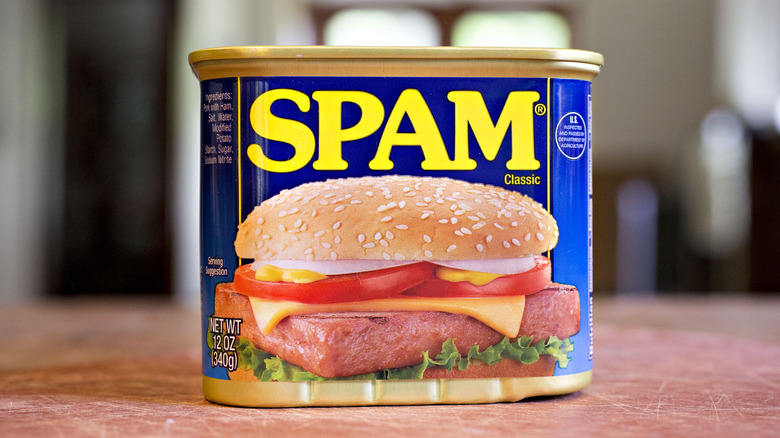Why Chef Chris Oh Will Always Love SPAM - Exclusive
For many people, the word "SPAM" first brings to mind all the junk email cluttering up our inboxes rather than the canned meat product created by Hormel Foods back in 1937 (via SPAM). For others, the association they have of SPAM is of a low-quality food product not well-suited to use in any decent dish. But for many more folks out there, SPAM is a beloved foodstuff that is welcome in just about anything, from sushi to soup to sandwiches and beyond.
One such tried-and-true SPAM aficionado is celebrity chef Chris Oh, who extolled his love for this classic meat product in no uncertain terms during a recent interview with Mashed. "SPAM has played such a huge part in a role in my life, just growing up," Oh said. "It's been a staple food throughout my whole life. And as a chef, you look at ingredients, SPAM kind of hits every note of one of those perfect ingredients. It's so versatile. You can deep fry it. You can pan-fry it. You can steam it. You can boil it. You can put it into soups. You can put it into sandwiches. You can put it in tacos. It's just one of those ingredients that you don't get with other ingredients and whatnot."
And Oh went on to compare SPAM to foods most of us may never have associated with the canned meat, saying: "You can easily take like a good piece of meat or a good piece of fish and just let that kind of speak on its own. I really feel like SPAM is kind of very similar stuff because you have the salty notes, you have those textural differences and whatnot. And, personally, every culture that I've seen has definitely used SPAM. Whether it's Korean or Japanese or Mexican, the Hawaiian. Obviously, Hawaiian food has got a big staple with the SPAM. So it's just a versatile product. And on top of that, it's very delicious."
But what is SPAM, anyway?
While SPAM is a processed product and is less nutritious than fresh meat, it is made using many fewer ingredients than you might expect. In fact, according to SPAM.com, it consists of pork with ham, salt, water, potato starch, sugar, and sodium nitrate, a common preservative.
As for the actual production of SPAM, the brand's site explains it this way: "First, the pork and ham are pre-ground. Then, salt, sugar, and the rest of the ingredients are added and mixed, to reach the desired temperature [sic]. From there, the mixture is moved over to the canning line, where it's filled into the familiar metal cans, 12 ounces at a time. Once filled, cans are conveyed to a closing machine where lids are applied through vacuum-sealing. Next, the cans are cooked and cooled for about three hours."
So not really all that off-putting of a production process. This helps explain why the stuff tastes surprisingly good and has enjoyed such staying power. SPAM is sold in more than 44 countries around the globe. It now comes in 13 different varieties, including those made with turkey, bacon, Portuguese sausage, to name a few, and according to estimates, more than 12 cans of SPAM are eaten every second of the day.
Take Chris Oh's advice and cook with SPAM. For more info, check out www.SPAM.com/recipes.

